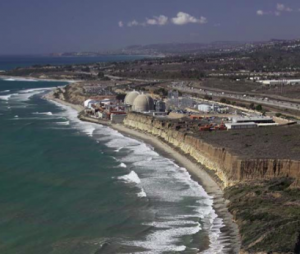
Changes at the San Onofre Nuclear Generating Station that “crammed” 400 additional tubes into one generator resulted in a radiation leak, according to a recently released study by an environmental advocate.
The extra tubes weakened the generator’s foundation, claims the Washington, D.C.-based Friends of the Earth, and removal of a supporting “stay cylinder” to prevent vibration caused the tubes to rub against other apparatus, which resulted in the leak in January and the indefinite shut down of both nuclear steam generators. The cause of the leak is also under investigation by nuclear officials.
Today, a day after a 3.9 earthquake struck a few miles west of San Onofre, Irvine’s City Council will consider sending a letter to the Nuclear Regulatory Commission demanding closer scrutiny of the plant’s safety as well as permanent off-site storage for spent nuclear fuel. The Laguna Beach City Council has recently supported San Clemente’s lead in voicing concern over the nuclear power plant’s safety.
With fallout from Japan’s tsunami-bred nuclear disaster as a road map, Irvine is also asking regulators to order the plant’s operator to expand the evacuation zone to 50 miles from its present 10-mile radius and provide emergency services accordingly.
The equipment changes, approved by the NRC, occurred when Southern California Edison, the plant’s operator, replaced four steam-generating motors. Each of the two nuclear reactors at the plant house two steam-generating engines.
“Yes, of course we were aware of their design change,” said Lara Uselding, an NRC spokeswoman. “As part of our inspection activities for rotor replacement in both units in 2009 and 2010, a portion of their engineering design change was reviewed by the inspectors.”
Scott Andresen, a spokesman for Edison, said the changes were not technically “design” changes but equipment changes. All four steam generators were replaced. “The new steam generators have the same form, fit and function as the old steam generators just with new technology,” said Andresen. “The old steam generators were nearing their life expectancy. They had been there for about 25 years.”
The ramifications of replacing the tubes and any ensuing vibration that could lead to leaks are currently under analysis. The NRC dispatched its inspection team to San Onofre shortly after the first unit was shut down on Jan. 31, according to an NRC statement. A public announcement will be made when the inspection is complete, Uselding said.
Holes were drilled in the tube sheet, a foundation supporting the generator, to accommodate the new tubes and a “stay cylinder” securing the generator was removed to accommodate the new tubes, according to the Friends of the Earth report.
These changes at San Onofre, made 20 months ago, resulted in increased vibration and wear on the tubes, causing them to leak, according to analysis by nuclear engineer Arnie Gundersen, a former nuclear industry executive and licensed reactor operator now questioning the safety of nuclear power. The report questions whether the changes represent exact replacement of the original generators, which is how they were presented by Edison for approval to the NRC.
“Here’s a tip: when your nuclear reactor is springing leaks and radioactive pipes are deteriorating 20 times faster than they should, it’s a big deal, and no amount of nuclear spin by Edison or the NRC can hide that fact,” contends Shaun Bernie, a nuclear specialist allied with the advocacy group. Friends of the Earth, led by former federal Energy Department policy advisor Bob Alvarez, was credited for helping draft and pass the 2002 California Clean Cars Law, the nation’s first to regulate greenhouse gas emissions from passenger vehicles, set to become effective in 2018.
Replacement of nuclear reactors during the 40-year initial license period is routine, according to Joseph Gonyeau on his Virtual Nuclear Tourist website. Gonyeau, a former NRC reactor operator and U.S. Navy nuclear program engineering officer, reported that when 15 percent of the more than 3,000 tubes in a nuclear steam generator are plugged, heat transfer properties deteriorate and replacement is required to maintain the plant at full power. “Typically, an outage will require 35 to 60 days to replace steam generators,” Gonyeau writes, adding that a steam generator costs more than $100 million.




